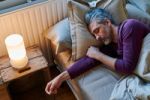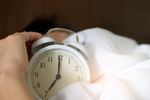Prime your body for relaxation and rest by targeting these points before hitting the hay.
Not being able to will yourself to sleep as the minutes on the clock tick closer to sunrise can feel frustratingly helpless. If falling and staying asleep is something you regularly struggle with, there’s a good chance your kitchen is stocked with chamomile tea, your medicine cabinet contains a bottle of melatonin and you’ve tried to give yourself an evening tech-cutoff time.
While there’s no silver bullet for good sleep (if only it was that easy), it’s certainly helpful to have as many tools at your disposal as possible, and one that often flies under the radar is acupressure. Acupressure is a way to address a range of ailments — e.g. muscular tension, chronic pain, insomnia — by applying pressure on specific points on the body to balance the flow of physiological energy or qi. It’s a type of acupuncture, but unlike acupuncture, there are no needles involved.
So, how does this hands-on treatment help you score a solid night of zzz's? Keep reading to find out that answer — plus six pressure points for sleep and how to target each before hitting the lights tonight.
How Can Acupressure Help With Sleep?
As mentioned above, acupressure — like acupuncture, except without needles — is based on the idea that targeting acupoints allows you to manipulate the flow of energy within the body to restore balance and, in turn, address health concerns.
While there are plenty of reasons you might struggle with shut-eye, two common culprits are stress and anxiety. Not only do these challenges make it difficult to unwind both mentally and physically, but, according to Chinese Medicine, they also stop the flow of qi throughout the body, which also contributes to trouble sleeping.
That’s where acupressure comes in.
“Pressure points are specific areas of the body that have a larger influence on the whole body,” says Ashley Flores, LAc, a licensed acupuncturist who is certified in Chinese herbal medicine. “When we activate those points, they send a message to the body to either relax [a body part that] is too tight or to bring more energy to an area that is too empty.”
In addition to helping restore the flow of qi, accupressure can also be an effective sleep aid by simply forcing you to slow down and partake in a grounding practice before shutting off the lights. "The action of sitting quietly and doing something caring for yourself is very calming," and, in turn, can promote sleep, notes Flores.
RELATED: Sleep Affirmations to Try for a Restful Night
And while more research is still needed, there are a handful of studies that back up the idea that acupressure can help you catch some zzz’s. A small study from 2011, for example, found that four weeks of acupressure treatment reduced sleep latency as well as improved sleep quality and duration amongst participants.
There is also some evidence showing that acupressure can help alleviate pain, including lower back pain, menstrual cramps and chronic headaches — all of which could otherwise negatively impact sleep.
RELATED: Holistic Ways to Treat Headaches
6 Pressure Points for Sleep
If you’re interested in giving acupressure a try, Flores recommends first meeting with an acupuncturist, who can show you in person how to do it. After all, they’re trained on the very subject — plus, they can also discuss other sleep solutions to incorporate into your routine since a holistic approach can often be the most effective. (Pro tip: Head over to THE WELL website to easily schedule an initial consultation with one of our Chinese Medicine experts.)
That being said, if you’re set on giving acupressure a go tonight, ahead are six pressure points for sleep as recommended by Flores and Jill Harrison Landsman, LAc, DAOM, a licensed acupuncturist and herbalist.
Anmian Point
Anmian is the first pressure point that Flores along with Landsman recommend for better sleep — and that’s not all that surprising given its often referred to as “Peaceful Sleep." Still, it’s a pretty good sign, no? Anmian is located where the jawline and neck connect, below the ear, which is “right over the vagus nerve, which sends a lot of calming signals to the body,” Flores says. And relaxing mentally and physically is key for a sound night of zzz’s.
Use your index and middle finger to apply pressure for between two and five minutes.
Kidney 6 and Kidney 27
Kidney 6 is located on the inside of the ankle, and Kidney 27 is on the lower border of the collarbone. While the two points are on opposite sides of the body, they work as a “complementary pair for nervous system regulation and sleep,” says Flores. Applying pressure to both of them — either simultaneously or consecutively — can help switch the body from fight-or-flight to rest-and-digest, helping to “reduce someone’s cortisol if they’ve been under a lot of stress,” she explains.
When it comes time for application, use your index fingers to apply pressure to Kidney 6 for two to five minutes before doing the same for Kidney 27 or vice versa, as “there isn’t a particular order they need to be treated in,” according to Flores.
Shitsumin
“Sometimes, people get overheated and restless at night,” says Flores. “In Chinese Medicine, we describe it as there being too much heat rising in the body, and this makes it so that the body can’t calm down and go to sleep.” If you can relate, consider focusing on the Shitsumin point, which is located on the base of each heel, before hitting the hay. You can do this by holding your foot in one hand and using your thumb to apply pressure for a few minutes before switching feet.
Alternatively, you can soak your feet in hot water for 15 minutes. Although it may sound counterintuitive, doing this before climbing into bed can help reduce some of that sleep-distributing heat. This helps increase blood flow, moving the heat through the body.
San Yin Jiao (SP6)
In general, Sin Yin Jiao — which is located above the highest point of your ankle (i.e. the ball-like bone) — is “a wonderful [pressure] point for sleep,” says Flores. “I use this one for all kinds of nervous system regulation and switching the body out of fight-or-flight.” But helping your brain and body calm down (and, in turn, score some zzz’s) is only one perk of this point. “SP6 is also used a lot for hormonal regulation and blood flow in the uterus, so it would be a particularly good choice for insomnia related to the menstrual cycle,” Flores explains. In fact, a 2010 study found that employing this pressure point majorly decreased the severity of menstrual cramps. And while we’re talking about research, it’s also important to point out that other studies suggest that targeting this acupoint can “improve sleep quality, lengthen deep sleep and REM duration” amongst those with insomnia.
Sit with one ankle crossed over the opposite knee to allow for easy access to this presure point. Apply pressure with your thumb or pointer finger for 30 seconds to one minute before switching sides.
Heart 7 (Shen Men)
Anxiety or depression responsible for your sleeplessness? Make sure to include Heart 7 or Shen Men during your pm acupressure routine since it’s connected to emotional regulation, including anxiety and worry, explains Harrison. Massaging the acupoint — which is located just below the pinky on the crease of the wrist — has also been shown to be an effective tactic for alleviating insomnia, specifically amongst older adults and those with Alzheimer’s disease and sleep disorders.
Use your thumb to apply pressure to Heart 7 on one wrist for a couple of minutes before repeating on the other wrist.
Bottom line? While what’s most important is to treat the root causes of why you can’t sleep, pressure points can be a helpful way to relax before bed. Consider it one more tool in your wellness tool box; one that will hopefully have you resting easy.





